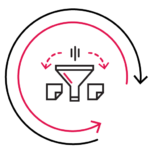Is the Scaled Agile Framework (SAFe) Here to Stay?
As an Agile Coach, I have worked with many different frameworks while supporting a variety of clients over the past several years. Hence, I have implemented SAFe (Scaled Agile Framework) for many projects as an SPC (SAFe Program Consultant). One of the questions that I have received frequently is likely something that many others have heard: “Is Agile just another buzzword?” Similarly, I have also heard, “Is SAFe worth learning or will it be replaced by something else soon?”
While it is difficult to predict the future in today’s chaotic world, we can draw some insights by looking at recent trends regarding the future of Agile and SAFe. Since I have been working in this domain for many years, I have studied many frameworks and methodologies and followed the trends closely to try to stay aligned with the industry. I have implemented LeSS, Disciplined Agile, SAFe and Nexus, all of which are tracked and monitored by the annual State of Agile Report that is published by CollabNet. This report provides interesting data related to the adoption of these frameworks, and I have summarized the results using the data from the past 3 years (shown below).
A disclaimer

As you might be able to tell immediately, SAFe has dominated the market for the past 3 years for scaling frameworks when it comes to Agile methods. This report goes back further, but the trend remains the same – SAFe is the leader when it comes to scaling agile teams/programs, and continues to gain ground year after year.
While this trend may encourage many agile practitioners to jump on the bandwagon, how do we know if this trend will continue? There are a few factors that indicate that SAFe will continue to be the leader for years to come in this domain.
Let’s take a look at a few.
Customer adoption
One of the key factors behind the popularity of any framework is dictated by the community and the customer base. In the case of SAFe, Scaled Agile Inc. has masterfully crafted its framework and supporting training programs to enable large organizations including government entities around the globe to adopt SAFe in a meaningful way. Given that processes and tools typically take a long time to deploy (and replace) within the government sector, the fact that SAFe is a part of this domain implies that it will likely be around for many more years to come.
Success stories
As compared to other frameworks, SAFe has many success stories and continues to broaden its reach globally, which is likely the reason it remains the market leader in this space. Other competing frameworks do not have the same level of adoption, which makes it much more difficult to grow.
Dissemination of knowledge
Through the SPC (SAFe Program Consultant) strategy, Scaled Agile Inc. developed a way for companies to deploy SAFe in a cost-effective manner by allowing them to build their own SAFe competency. By enabling SPCs to run formal training courses and providing them the resources and tools to do so virtually, you can implement SAFe across large teams even across different time zones for a distributed workforce.
Formal structure

Conclusion
To wrap up this article, is SAFe here to stay? The data seems to suggest SAFe has positive momentum and will likely continue to be a significant player in the scaling framework market. If you are a practitioner trying to decide whether to learn SAFe, the obvious choice is to go ahead and add this tool to your toolbox, even if you may not need it immediately. If you are an organizational leader trying to decide whether to adopt SAFe, my suggestion is to talk to your peers who have already embarked on this journey to learn about their experience. It is also advisable to talk to a professional Agile Coach who has experience helping companies choose the right approach to focus on achieving the desired business outcomes.



